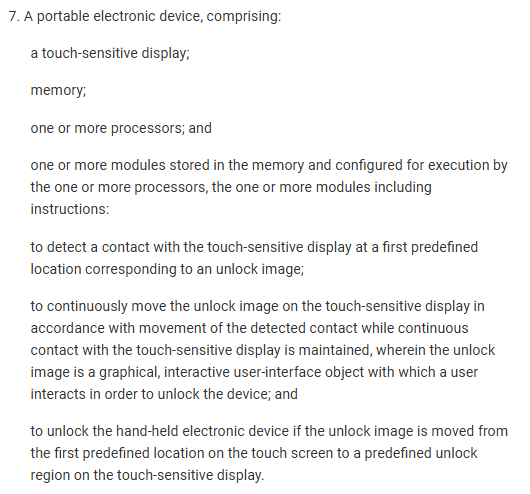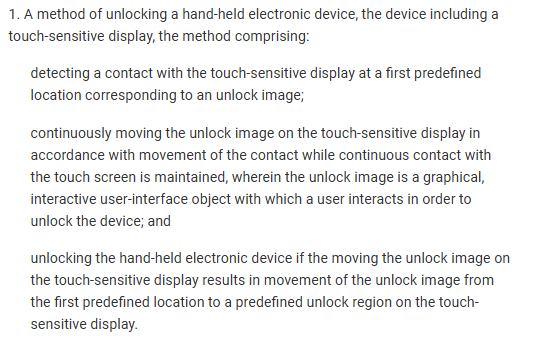How to Obtain Patent Protection for Software and Systems including Software in Australia
The law in relation to software patentability in Australia is constantly evolving due to changes in IP Australia policy and practice, and Federal Court decisions. This leads to some complexities in determining patent eligibility in Australia. In assessing the patentability of software inventions, IP Australia and Australian courts assess the "substance" of the invention, not solely its form. They look for an aspect of a patent claim that provides a technological solution to a technological problem as opposed to a business solution. The seminal Australian High Court Case National Research Development Corporation v Commissioner of Patents (1959) established that "manner of manufacture" is the key requirement for patentability. The courts have further interpreted this to require the invention to have a material effect or tangible outcome in the field of economic endeavor. Therefore, software implemented by a system that provides tangible, concrete effects as a result of a technical process are generally more likely to be held as patentable subject matter. This includes enhancements to the computer itself (e.g. data compression algorithms) or improved measurement/simulation of physical systems (e.g. novel sensor data interpretation). Software that essentially implements abstract or business ideas, like business methods, particularly using standard computer technology are unlikely to be deemed patentable.
Case Law on Software Patentability
Case law in Australia has refined, with some level of oscillation, what might be regarded as the "substance test" over time. Here are some key decisions that have influenced IP Australia’s approach:
- Grant v. Commissioner of Patents (1998): This case emphasized that a mere business scheme or a method, the steps of which could be performed manually, is not patentable simply because it's implemented using a computer. The court held that for a method to be patentable, it must involve a physical transformation or manipulation of matter. In this case, the invention involved a method for structuring a financial transaction to protect assets from creditors. The court found that this method did not involve any physical transformation or manipulation of matter, and therefore was not patentable subject matter.
- CCOM Pty Ltd v Jiejing Pty Ltd (1994): Highlighted that patent protection cannot extend to abstract ideas or mental processes, even if performed on a computer. In this case, the court held that a method for generating Chinese characters using a computer was not patentable because it involved a mental process that could be performed without a computer. The court found that the use of a computer to implement the method did not add enough to the process to make it patentable.
- Research Affiliates LLC v Commissioner of Patents (2014):Introduced the concept that a mere "implementation" of an abstract scheme on a generic computer would likely fail to meet the "manner of manufacture" requirement. The court emphasized that simply implementing an abstract idea or mathematical formula on a computer, without adding any new technical features or improvements to the computer's operation, is not sufficient to make it patentable subject matter. In this case the court found that the claimed invention, a method for valuing securities, was essentially an abstract mathematical formula that could be performed manually or by computer. The court held that the mere implementation of this formula on a computer did not transform it into a patentable invention.
- Commissioner of Patents v RPL Central (2015): In this case the court found that the claimed invention, a method for valuing securities, was essentially an abstract mathematical formula that could be performed manually or by computer. The court held that the mere implementation of this formula on a computer did not transform it into a patentable invention. This case set out a useful two-step test to determine whether the computer is a manner of manufacture:
- merely a tool to implement the method, or
- integral to the invention in that a method embodied in the software solves:
- a technical problem within the computer
- a technical problem outside the computer (possibly in different fields of technology that have their own technical problems), or
- results in an improvement in the functioning of the computer.
- Rokt Pte Ltd v Commissioner of Patents (2020): Reaffirmed that computerized business methods or schemes are generally excluded, but patent protection may be possible if the invention produces a technical outcome. In the case, the court found that the claimed invention, a digital advertising system and method, did not involve a sufficient technical contribution to be patentable. The court held that the invention was essentially a business scheme that could be performed manually or by computer, and that the use of a computer did not add enough to make it patentable.
- Aristocrat Technologies Australia Pty Ltd v Commissioner of Patents (2022):The implementation of a scheme or idea on a computer to create an artificial digital state of affairs should not be treated any differently from the implementation of a scheme or idea by any other machine to create an artificial physical state of affairs. In both cases, however, the implementation must do more than merely manipulate an abstract idea.
Due to an odd occurrence of a split bench, the High Court decision deferred to the decision of the Full Federal Court which found that while the claimed invention was computer-implemented, it was not an advance in computer technology and therefore not patentable subject matter. What makes this problematic is that the High Court had, at the same time, agreed that the test applied by the Full Federal Court was incorrect. That being:- Is the claimed invention a "computer-implemented invention"?, then if so:
- Can the invention claimed broadly be described as an advance in computer technology?
The High Court Decision seemed to indicate that an advance in computer technology is not essential for the Australian patentable subject matter requirement to be met and so computer-implemented inventions that offer a technical advantage in another field of technology may constitute patentable subject matter.
How the invention is characterised remains crucially important and was the determining factor in the split in the High Court. Clearly, the door has been left open for the High Court to consider the issue of computer implemented inventions further.
Hypothetical Patentability Examples
Patentable:
- Novel data compression algorithm:This invention focuses on improving the efficiency of storing and transmitting data using unique computer algorithms, resulting in a tangible effect.
- Software for optimizing traffic flow control:This software utilizes AI algorithms to analyze traffic patterns and suggest adjustments to traffic lights in real-time, leading to a concrete physical effect on traffic flow.
- Image processing software with noise reduction capabilities:This software employs innovative algorithms to remove noise from digital images, offering a clear visual improvement, which is a tangible effect.
- Software for controlling a robotic arm with enhanced precision:This software introduces novel algorithms for controlling a robotic arm, resulting in increased accuracy and precision in its movements, which is a physical effect.
Patentability Unlikely:
- Software for managing customer relationships (CRM):This software primarily automates business processes like customer data management and communication, which are considered an abstract idea (business method) and lack a tangible technical effect.
- Software for online stock trading:This software facilitates the execution of stock trades but solely operates on existing financial processes and information, offering no novel technical contribution beyond the abstract idea of trading.
- Software for social media platform algorithms:These algorithms often focus on user engagement, content ranking, or advertising display, which are abstract concepts related to content presentation and do not produce a concrete technical effect.
- Software for online booking systems (e.g., restaurant reservations):This software simplifies the booking process but primarily automates an existing business practice, lacking a new technical solution or tangible effect.
It's important to note that these are just examples, and the patentability of a specific software invention ultimately depends on its unique characteristics.
What Makes Software More Likely to Be Found To Include Patentable Subject Matter?
- If the invention provides a technical solution to a technical problem
- Involvement of a computer in the invention and where that computer is inextricably linked with the invention itself – where the computer integral to the invention.
- If the invention is addressing a technical problem within a computing device.
- If the invention results in an improvement in the functioning/performance of the computer or system.
- If the invention requires more than generic computer/software implementation.
- If the invention lies in more than the generation, presentation or arrangement of intellectual information.
Famous, Recent Software Patents
1. U.S. Patent No. 9,959,512 B2 - Uber’s System and Method for Operating a Service to Arrange Transport Amongst Parties Through Use of Mobile Devices
Uber’s claim on a ride-hailing service application was granted in the US. The patent offered solutions to various ride-hailing problems faced by people around the world. Some ride-hailing problems addressed include: 1) unpredictability in the cost of the ride; 2) minimal hailing vehicles; and 3) lack of driver’s knowledge on the specific drop-off point. This patent was one one of the broadest patents Uber has and it is used to protect their software for ride hailing or arrangement services.
CLAIM & DRAWINGS
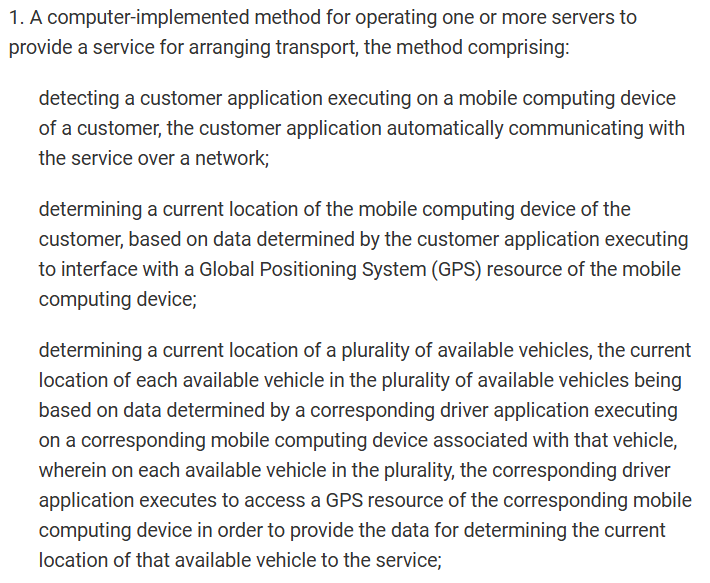
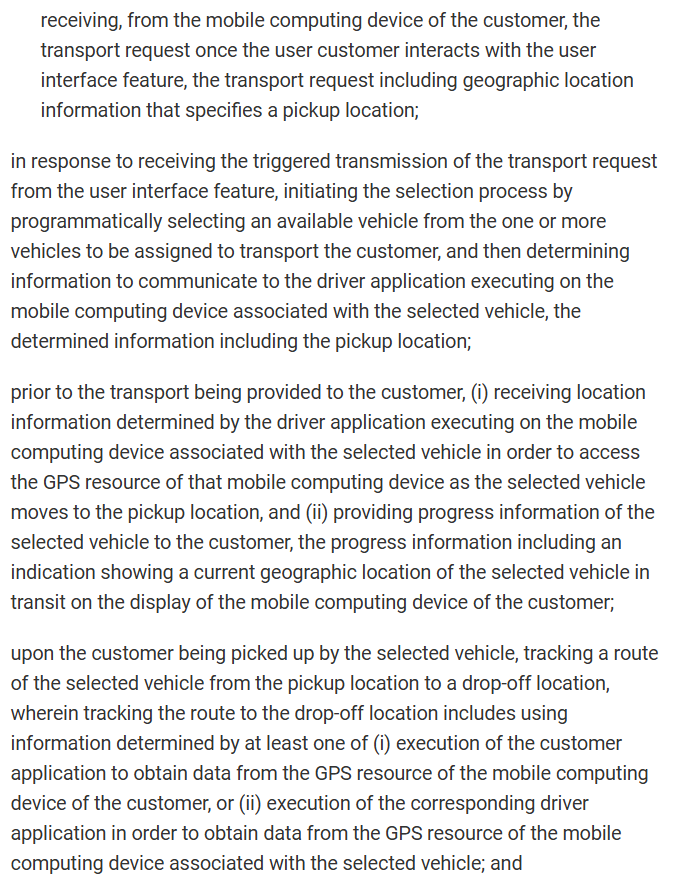



2.Australian Patent No. AU2016265852B2 - Canva’s Multi-user System for Creating Brand Collateral
This patent protects Canva’s technology which allows multiple users to interact with the same design within the application simultaneously. This facilitates collaborative design between users and is particularly useful for teams working on brand assets, as they can simultaneously work together on a design project. The technology also provides a cloud-based real-time update such that the simultaneous collaboration and edits of the multiple users on a file is immediately reflected.
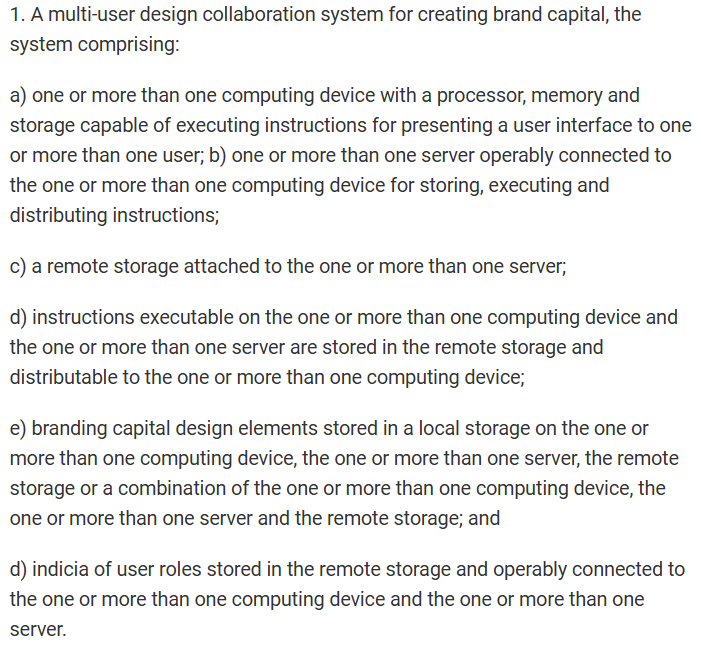
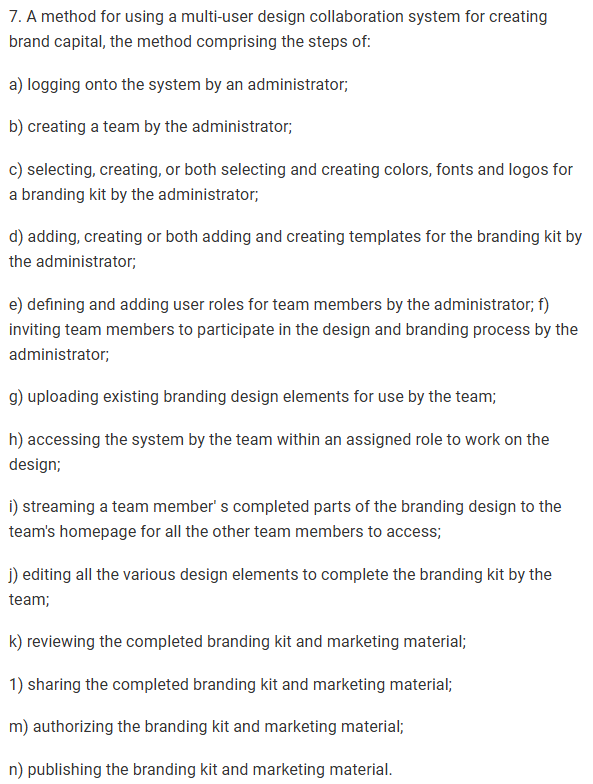

3. U.S. Patent No. 10,467,553 B2 - AirBnB’s Automated Determination of Booking Availability for User Sourced Accommodations
Significance of the patent is that users are readily informed of the availability of a rentable residential space for a preferred schedule. The software from the patent also gives real-time information on the availability. It likewise provides the cost for such residential space. The software also provides a recommendation feature on a user interface based on the user’s preferred location, price, or other user preferences and parameters.
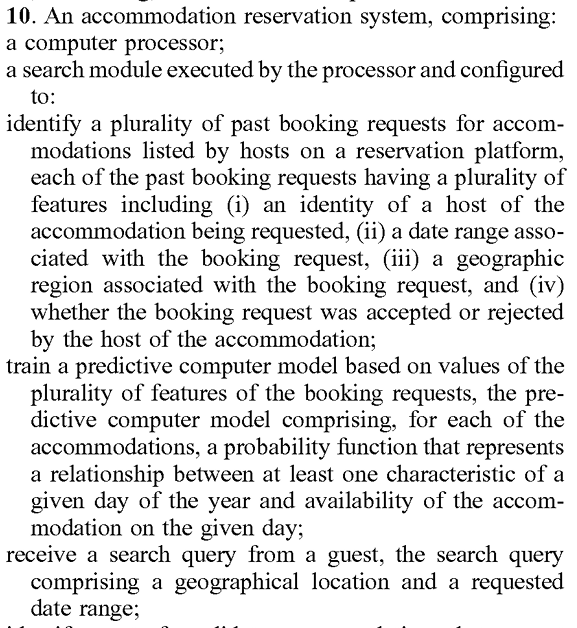
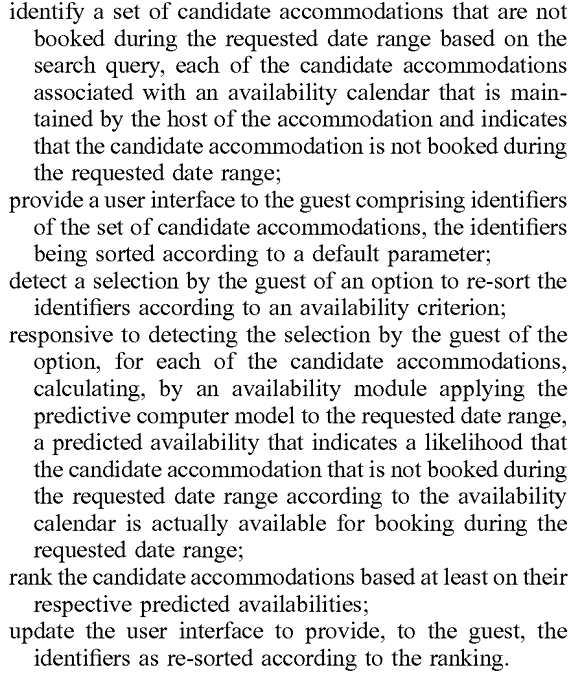


4. U.S. Patent No. 10,614,430 B2 - Coinbase’s Instant Exchange
In this age of blockchain technology and its use for cryptocurrency, this patent of coinbase allowed them to readily and instantly exchange a first type of digital currency or fiat currency to a second type of digital currency or fiat currency. This allowed users to have instantaneous exchange of cryptocurrency or fiat currency. This removed the requirement of the use of Peer-to-peer transactions where one needs to wait for their transaction to be matched by another user on the same exchange. Coinbases uses this patent as a defensive asset to protect their IP in crypto exchanges.
CLAIM & DRAWINGS
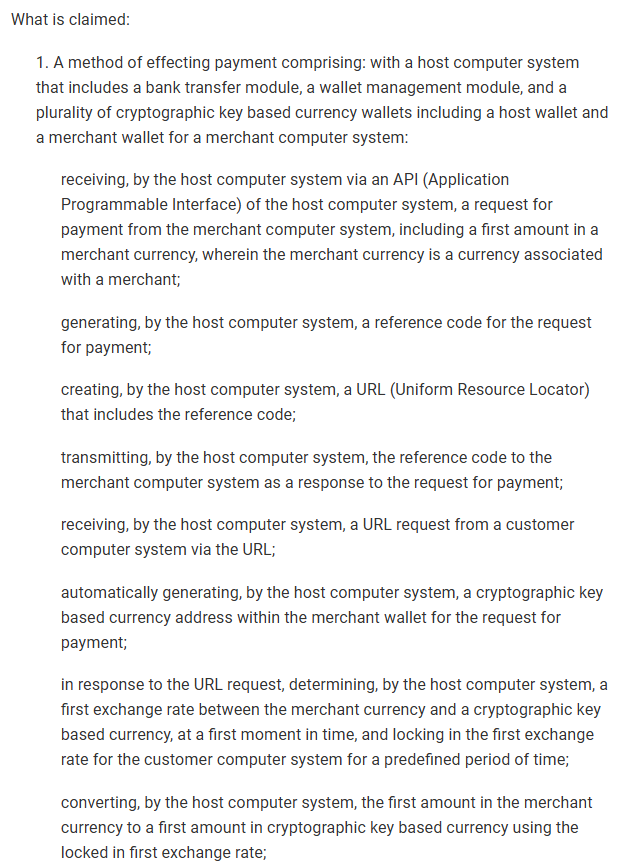
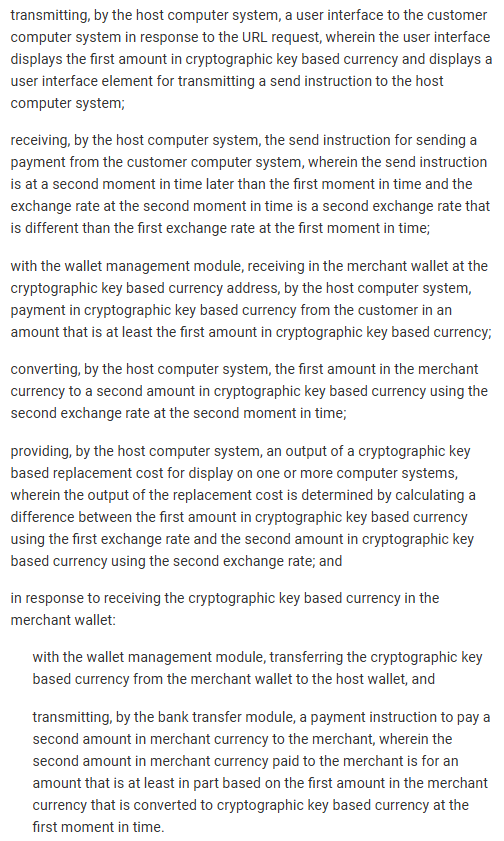

5. U.S. Patent No. 11,100,922 B1 - Amazon’s System and Methods for Triggering Sequences of Operations based on Voice Command
The subject patent describes a system that enables the triggering of multiple operations or actions based on a single voice command. This is applied in smart home technologies where an utterance of a word by the user can simultaneously trigger activation of multiple appliances, or trigger such appliances to perform various actions. The system also allows personalization such that the user can easily modify what words would result in the operation of each appliance. The system provides a personalized experience on how a user controls various appliances within a location with a voice command.
CLAIM & DRAWINGS
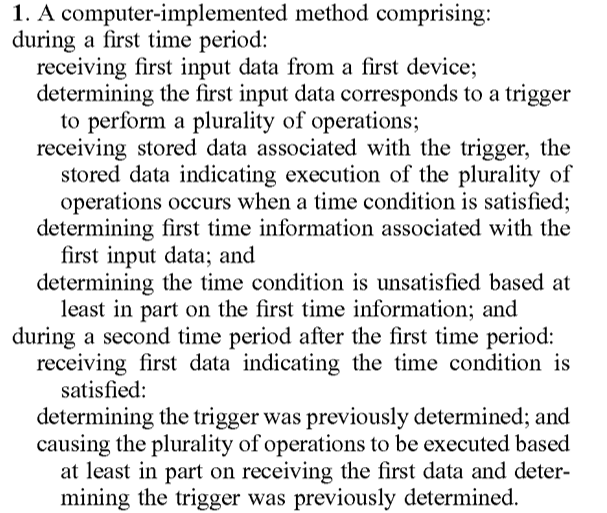
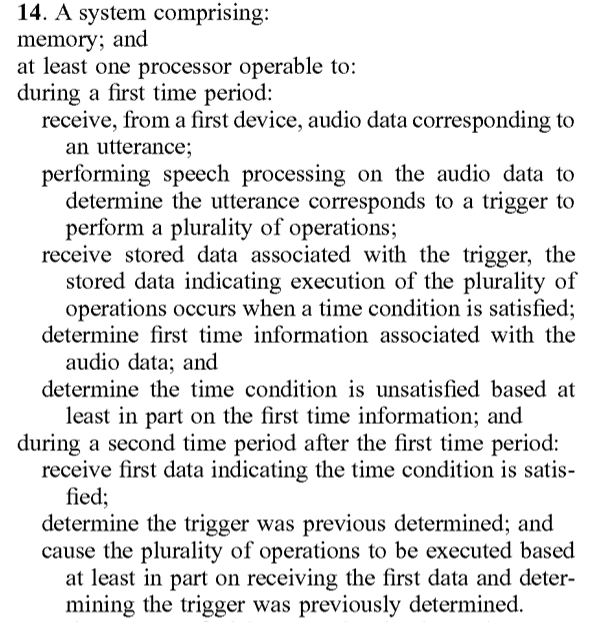

6. U.S. Patent No. 10,877,637B1 - Amazon’s Voice-based Device Operation Mode Management
This Amazon patent relates specifically to Amazon’s echo hub. Amazon’s echo hub functions as a hub for controlling a wide range of smart home devices within the house such as lights, security cameras, speakers, kitchen appliances, locks and other Internet-of-things devices. Amazon’s echo hub centralizes the functions of each smart device within the house and is integrated with Amazon’s Alexa voice command. It can operate in both a touch screen and voice command mode.
CLAIM & DRAWINGS
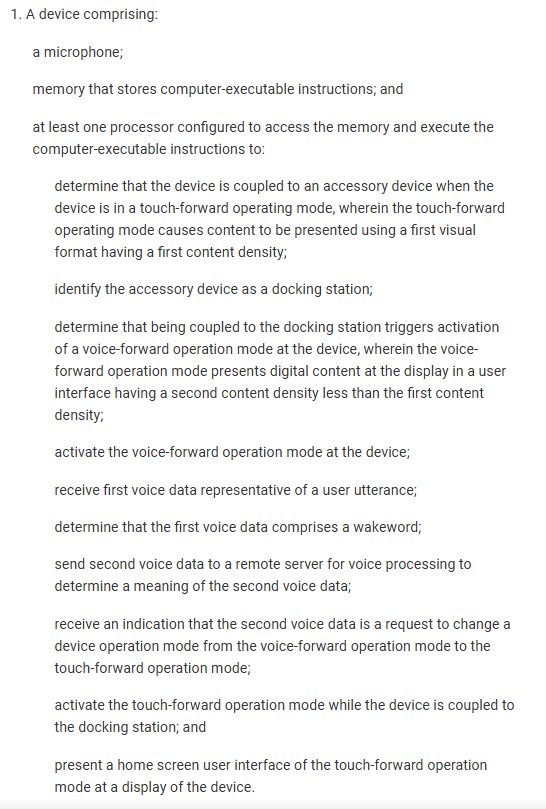
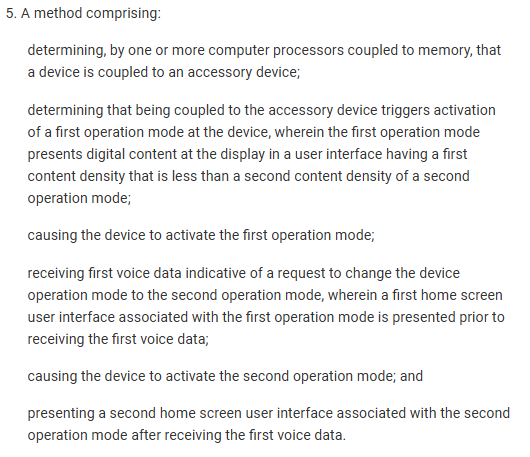

7. U.S. Patent No. 8,868,481 B2 - Google’s Video recommendation based on video co-occurrence statistics
This patent was significant in improving Youtube’s (owned by google) recommendation algorithm. The patent introduces a method for recommending videos based on how frequently they are co-watched with a target video - which allows youtube to suggest videos based on viewing habits. One of the issues sought to be solved by the patent is that other videos uploaded do not receive adequate visibility due to lack of co-watching data. The patent’s co-occurrence statistics feature allows the system to recommend a wider array of videos.
CLAIM & DRAWINGS
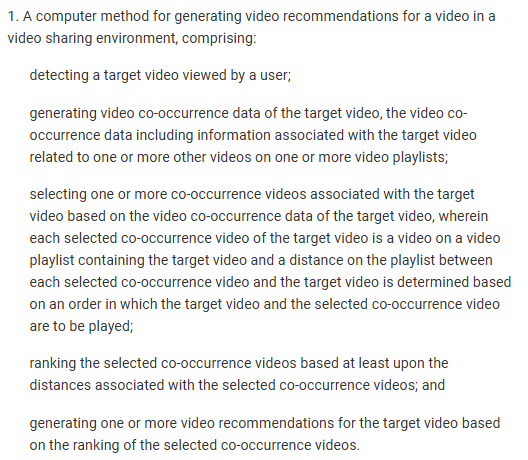
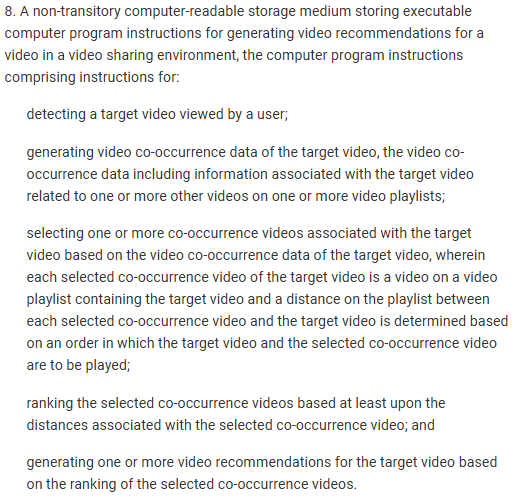


8. U.S. 9,503,500 B2 -Spotify’s systems and methods of classifying content items
This patent holds significance for Spotify’s content delivery of music. The patent allows Spotify to classify music based on various attributes such as what type of genre the music is, the general genre of the playlist it belongs to and what genre the other music that belonged to that playlist is. It allows Spotify to enhance user experience especially when users use the radio mode of Spotify, where the user allows the system to pick music based on the genre or mood of previously played music.
CLAIM & DRAWINGS
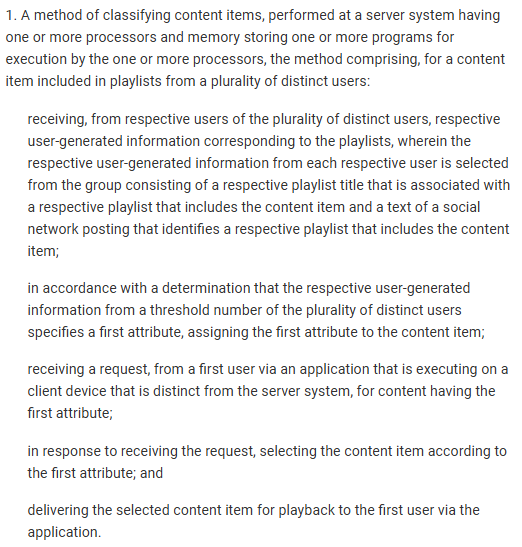
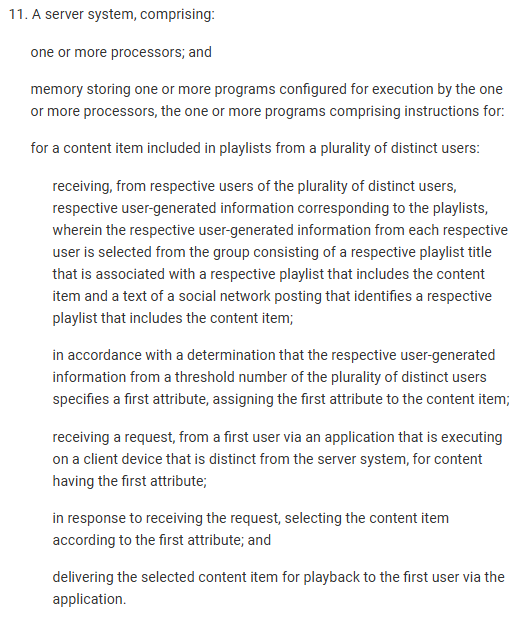


9. US 8,046,721 B2 - Apple’s patent on unlocking a device by performing gestures on an unlock image
Apple’s slide-to-unlock phone feature has been present on their phones since 2007.
CLAIM & DRAWINGS
